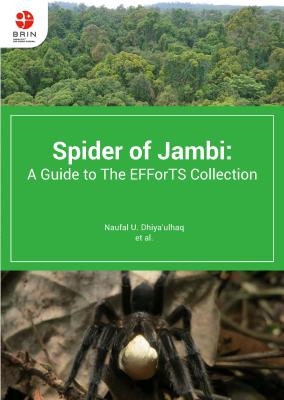Spiders of Jambi: A guide to the EFForTS collection
Keywords:
spider, Biodiversitas, rainforestSynopsis
Spiders are excellent predators of considerable ecological importance, consuming roughly half a billion tons of animal prey annually worldwide. Some are also great architects, constructing elaborate capture webs dozens of times their size.
Despite that, research about biodiversity, biology, and behavior of spiders is still lagging behind, especially compared to the jaw-dropping speed of habitat destruction and the associated extinctions of species worldwide. This is particularly true in tropical Southeast Asia, home to several biodiversity hotspots. The likely number of Indonesian spiders is at least twice that of the currently recorded number of species, if not even higher.
This book aims to showcase part of the immense diversity of Indonesian spiders. We hope this book is more than just a report of what we found; it also serves as a basis for future spider research in Indonesia. We hope this book can motivate citizens interested in spiders and study the immense diversity of spiders
Downloads
References
Aviles, L. (1994). Social behaviour in a web-building lynx spider, Tapinillus sp. (Araneae: Oxyopidae). Biological Journal of the Linnean Society, 52(2), 163–176.
Deeleman-Reinhold, C. L. (2001). Forest spiders of South East Asia: with a revision of the sac and ground spiders (Araneae: Clubionidae, Corinnidae, Liocranidae, Gnaphosidae, Prodidomidae and Trochanterriidae [sic]). Brill.
Drescher, J., Rembold, K., Allen, K., Beckschafer, P., Buchori, D., Clough , Y., Faust, H., Fauzi, A. M., Gunawan, D., Hertel, D., Irawan, B., Jaya, I. N. S., Klarner, B., Kleinn, C., Knohl, A., Kotowska, M. M., Krashevska, V., Krishna, V., Leuschner, C., ... & Scheu, S. (2016). Ecological and socio-economic functions across tropical land use systems after rainforest conversion. Philosophical Transactions of the Royal Society B: Biological Sciences, 371(1694), 20150275.
Foelix, R. F. (2011). Biology of spiders (3rd ed.). Oxford University Press.
Global Biodiversity Information Facility. (2023). GBIF Home Page. Retrieved February 14, 2023, from https://www.gbif.org
Gutierrez, D. R. (2020). Checklist of spider (Arachnida: Araneae) of Indonesia and New Guinea.
Jocque, R. & Dippenaar-Schoeman, A. S. (2006). Spider families of the world. Musee Royal de l’Afrique Central.
Junggebauer, A., Hartke, T. R., Ramos, D., Schaefer, I., Buchori, D., Hidayat, P., Scheu, S., & Drescher, J. (2021). Changes in diversity and community assembly of jumping spiders (Araneae: Salticidae) after rainforest conversion to rubber and oil palm plantations. PeerJ, 9, e11012.
Koh, J. K., Court, D. J., Ang, C. S. P., & Ng, P. Y. C. (2022). A photographic guide to Singapore spiders. National Parks Board.
Lin, Y., Shao, L., Hanggi, A., Caleb, J. T., Koh, J. K., Jager, P., & Li, S. (2020). Asianopis gen. nov., a new genus of the spider family Deinopidae from Asia. ZooKeys, 911, 67–99.
Lopardo, L., Giribet, G. & Hormiga, G. (2011). Morphology to the rescue: Molecular data and the signal of morphological characters in combined phylogenetic analyses—a case study from mysmenid spiders (Araneae, Mysmenidae), with comments on the evolution of web architecture. Cladistics, 27(3), 278–330.
Meehan, C. J., Olson, E. J., Reudink, M. W., Kyser, T. K., & Curry, R. L. (2009). Herbivory in a spider through exploitation of an ant-plant mutualism. Current Biology, 19, 892–893.
Murphy, J. A. & Roberts, M. J. (2015). Spider families of the world and their spinnerets. British Arachnological Society.
Nyffeler, M. & Birkhofer, K. (2017). An estimated 400–800 million tons of prey are annually killed by the global spider community. The Science of Nature, 104(3), 1–12.
Platnick, N. I., Hormiga, G., Jager, P., Jocque, R., Ramirez, M. J., & Raven, R. J. (2020). Spiders of the world: A natural history. Princeton University Press.
Potapov, A. M., Duperre, N., Jochum, M., Dreczko, K., Klarner, B., Barnes, A. D., Krashevska, V., Rembold, K., Kreft, K., Brose, U., Widyastuti, R., Harms, D., & Scheu, S. (2020). Functional losses in ground spider communities due to habitat structure degradation under tropical land-use change. Ecology, 101(3), e02957.
Potapov, A., Sandmann, D., & Scheu, S. (2019). Ecotaxonomy database. Retrieved February 14, 2023, from http://ecotaxonomy.org/.
Ramirez, M. J. (2014). The morphology and phylogeny of dionychan spiders (Araneae: Araneomorphae). Bulletin of the American Museum of Natural History, 390, 1–374.
Ramirez, M. J., Magalhaes, I. L., Pizarro-Araya, J., Ballarin, F., Marusik, Y. M., & Eskov, K. Y. (2022). A new species of the spider genus Tekellina Levi, 1957 from Chile, with a broadened definition of the family Synotaxidae (Arachnida, Araneae). Zoologischer Anzeiger, 301, 76–90.
Ramos, D., Hartke, T. R., Buchori, D., Duperre, N., Hidayat, P., Lia, M., Harms, D., Scheu, S. & Drescher, J. (2022). Rainforest conversion to rubber and oil palm reduces abundance, biomass and diversity of canopy spiders. PeerJ, 10, e13898.
Tanasevitch, A. V. (2021). New data on linyphiid spiders of Nepal (Arachnida: Araneae), with the description of a new genus and two species. Revue Suisse de Zoologie 128(1),107–119.
Wheeler, W. C., Coddington, J. A., Crowley, L. M., Dimitrov, D., Goloboff, P. A., Griswold, C. E., ... & Zhang, J. (2017). The spider tree of life: phylogeny of Araneae based on target-gene analyses from an extensive taxon sampling. Cladistics, 33(6), 574-616.

Downloads
Published
Series
Categories
License

This work is licensed under a Creative Commons Attribution-NonCommercial-ShareAlike 4.0 International License.






























